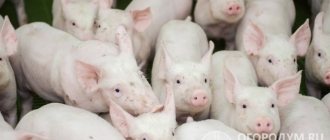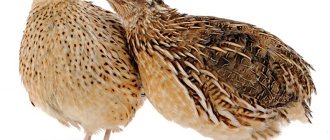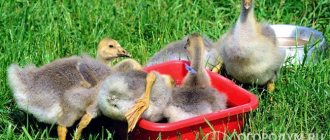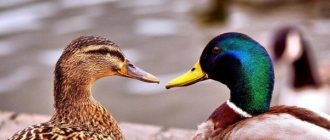Home » Articles about pigeons » How to distinguish a pigeon from a dove
To correctly form pigeon families, you need to know how to distinguish a dove from a dove. In this species of birds, sexual dimorphism is weakly expressed. To avoid mistakes, they practice an integrated approach.
How to distinguish a dove from a dove: external signs
By carefully observing pigeons, you can distinguish them by gender. Birds of different sexes differ from each other:
- color features;
- body structure;
- behavior;
- voice.
Color
In some breeds, a dove can be distinguished from a dove by the characteristics of its color - males have a more saturated shade. The main tone can be diluted with splashes of a different color. Such inclusions are most often present on the wings and tail. The bright color of the feathers attracts the attention of females and indicates the good qualities of the producer. If sexual dimorphism is inherent in the breed, then females have a muted plumage color. This feature allows the doves not to stand out in the area and ensures safety during breeding.
This method of determining gender is not applicable in all cases. Many breeds do not have pronounced differences in plumage shade.
If a farmer makes breeding pairs of birds of different colors, he can use this as a guide when separating the chicks. Males usually take on the color of their father's plumage, while females take on their mother's plumage.
Body structure
In most breeds, the difference between female and male lies in body size - pigeons are larger and heavier than pigeons. They have a short thick neck, a large round head with a high forehead and a strong beak. The base of the beak is wide, the wax is thick.
Females are more graceful than males, their necks are thinner and longer, their heads are smaller, their beaks are thinner and not so wide at the base. The cere is less rough. Expressive eyes. The wingspan of doves is also smaller.
This method of determining gender is also inaccurate. There are breeds in which males and females do not differ in size. In nature, males of one species of pigeon may look more graceful than females of another.
Skeleton structure
Females lay eggs, which affects the structure of the skeleton. You can tell a boy's pigeon from a girl's by feeling the pelvic bones. Before you begin the inspection, you should calm the bird. They take her in their arms, gently stroke her chest and go down to her stomach. The bones of the pelvis are located in its lower part. In the male they are close to each other. In the female, two pelvic bones are located at a distance of 2-3 cm.
This method is applicable if the dove has already laid its first eggs. It will not be possible to notice the differences until puberty.
An indirect sign that allows you to distinguish between a “boy” and a “girl” - when stroking the belly, the pigeon usually tucks its paws, while the dove relaxes and behaves calmly.
A dove sat on the window - a good omen
Almost only positive signs are associated with such feathered friends. If a bird has “settled” on the windowsill and appears there regularly, troubles will be avoided for a long time. Luck will smile, harmony will come to the house.
If the pigeon simply flew in and sat on the windowsill (perhaps knocked on the glass and flew away), this indicates the receipt of important news. It's safe to say they will be positive. If there was a twig in the beak, this indicates good news from loved ones. This sign is also relevant for birds that have landed on the eaves, balcony or roof of a house.
Our ancestors believed that birds do not fly to evil, bad people.
The white dove decided to fly around the house and then sit on the window - a very good sign. If a bird regularly flies to the windowsill like this, the people living in this house will not have any troubles
The calmer the pigeon behaves, the more favorable the events await in the future. The dove sat down on the windowsill and tries to attract attention (not aggressively, it is clear that he is not scared, he just wants to make contact), this indicates that his cherished wish will come true. Perhaps a child will be born, you will get a new position, you will win the lottery. He walks around the windowsill dancing - guests will soon arrive.
Character and habits
It is believed that female pigeons can be distinguished from male pigeons by their behavior. Doves usually react calmly to humans. Males may peck at an outstretched hand, perceiving the movement as aggression. When you try to gently pull the beak, they pull their head away.
A bird's behavior towards humans most often depends not on gender, but on temperament.
Relationships between same-sex individuals
If doves gather together, their behavior usually remains even and calm. Fights often arise between males for territory or for girlfriends. In the absence of reasons for mutual competition, they calmly coexist.
If a pigeon breeder doubts the correctness of sex determination, he can conduct a test. To do this, two presumably opposite-sex birds are placed in one cage. Behavior will show the true state of affairs - there are no fights between girls, boys will inevitably compete in tight spaces. Individuals of different sexes may become interested in each other and start mating games.
If the darling already has a mate or is not interested in the candidate, then she will be aggressive towards him. This behavior can be mistakenly interpreted as being considered male for pugnacity.
Females in rare cases can form a false pair, imitating a relationship. It is possible to identify an error only by unfertilized eggs and by their number in the nest (instead of two there will be four).
Relationships between different-sex individuals
It is not difficult to distinguish between a female and a male pigeon during the mating season - the relationship between birds of different sexes is indicative. Mating season begins in the spring. Males try to attract the attention of their girlfriends.
Pigeons:
- coo;
- they inflate their crop and spread their tail to appear larger and more significant;
- circle in place or follow an interested dove;
- spread a wing over the chosen one, as if hugging her;
- can demonstratively engage in nest construction, demonstrating the seriousness of their intentions.
If the groom is interested, the dove shows her affection by sitting on her tail, bowing and cooing gently.
If a pair has formed, the female usually reacts aggressively to other suitors.
Traditional methods
It is believed that birds were made domesticated 5-10 thousand years ago. During this time, many folk methods of determining gender have appeared. They are used to distinguish pigeons even today.
The easiest way is to check the reaction to contact with a person. Take the subject in the hand and stroke his chest. Male pigeons are distinguished by their tucked feet. Their girlfriends don't do this.
Planting birds in one cage
They watch the pigeon's reaction to its own or the opposite sex. To make it more noticeable, they limit the space: they put two birds in a cage. What happens next is:
- Male pigeons do not get along well. They begin to fight for leadership.
- Two doves behave peacefully.
- Once a couple is in the cage, courtship begins.
The method is not particularly accurate. There are different characters. Plus, lovebirds sometimes refuse the gentleman. From the outside, this can be mistaken for a fight between two rivals.
Using a Pendulum
Another popular method is loved by beginners. It is believed to be almost 100% accurate. Use a bronze, copper or brass pendulum:
- A small piece of one of these metals is tied to a thread, a thin rope. You can take a coin with a hole. The length of the thread is from the owner’s elbow to the fingers. It turns out to be a pendulum.
- They take the dove in one hand.
- The pendulum is placed over the genitals, the coccyx of the subject.
- They look at the characteristics of the movement. If the pendulum swings from one side to the other, it is a male for inspection. When the device rotates in a circle, the dove passes the test.
In a similar way, they sometimes look for water or pathogenic zones. The method has no scientific basis. Professional pigeon breeders, as a rule, criticize this method.
Determining the sex of chicks
Male chicks of most breeds weigh a little more, but the difference can only be seen on electronic scales (1-2 g). Given the restless behavior of young animals, it is difficult to track parameters. External differences are less noticeable than in adulthood, but upon close examination you can see the grace of the doves - their heads are slightly smaller, their beaks and legs are thinner.
You can focus on behavioral factors. “Boys” are more curious - when a foreign object is placed in the brooder, they strive to examine and study it, while “girls” try to move away from the potential threat. Under sound stress, the former take a defensive-observant position, and the latter press themselves to the floor. It is worth monitoring changes in behavior as you grow older. Males become more aggressive and bully each other. The doves behave calmly.
You can conduct a test by lifting the chick off the floor by the scruff of the neck - it is believed that the “girl” will tuck her paws, and the “boy” will hang with his body stretched out. The duration of the check should not exceed two to three seconds.
Chicks
Determining whether the person in front of you is a “boy” or a “girl” is even more difficult than in the case of adult representatives. Behavior (as in adults, when a dove hugs a dove) has not yet formed. Male chicks usually have larger heads and are larger. However, for some breeds there are exact criteria: “girls” Texans have long fluff, while “boys” have short fluff.
The Texan pigeon has pronounced sexual differences
Autosexity
There are autosex pigeons. The most famous breed from this category is the Texan. Sex can be determined as early as one day of age. "Boys" usually hatch bald or with very short fur. Their beak is light and monochromatic. Grown-up individuals have white or yellowish plumage interspersed with brown color. The spots are located in the chest, neck (less often - in other parts of the body). With age they become brighter. “Girls” are born with long yellow fluff; after a couple of days, brown spots appear on their beak. Adult doves have dark plumage. They have brown wings and tail, gray, lilac or blue breast.
Flight
These pigeons are easy to train and can fly for a long time without getting tired. Some of them were once used as post offices. Flight includes:
- Nikolaevskaya breed. These birds differ in their flight style - they fly vertically in a straight line and rise very high. They have a strong body and a small neck.
- Berlin short-billed tumbler. It is small in size and has a short beak, a very convex forehead, and wings hanging below the tail. The breed is very numerous. They have a plain or variegated color.
- German monk. They do not fly very high; during the flight they attract other birds. At the back of the head they have a hood made of feathers.
- Berlin long-billed. A very rare species. It has an unusual appearance - a vertical position of the neck and a horizontal position of the head, which is very narrow, and also has a thin beak.
Table of comparative characteristics for practical use
Pigeons often have difficulty determining the sex, especially for beginners. Even if you apply the methods correctly, errors or doubts appear. Each of the methods has disadvantages. There are contradictions.
Pigeon breeders have found a way out. They distinguish pigeons not by one, but by several characteristics at the same time. For this purpose, a special table has been developed, which contains the main verified characteristics.
In the table below you can check and compare the appearance and behavior of the lovebirds and their partners. This “cheat sheet” helps you not to forget anything. For example, several pigeons calmly stay together. They are believed to be females. Then they check for other characteristics: plumage color, head shape, etc.
| Sign | Pigeon | Dove |
| Size, build | Massive body, overall length and other dimensions are larger | Smaller measurements, petite body structure |
| Feather color | Inclusions that differ from the main color, patterns on the body, bright tints of green, burgundy and blue on the neck | Solid color, without bright shine or sharp transitions |
| Head | The head with a pronounced frontal part sits on a wide neck. The beak and wax are massive and well developed. The eyes are large, slightly protruding | Round, sitting on a thin neck. There are no irregularities or bulges on the head. Small cere and beak. Expressive eyes |
| Voice | Loud, in stressful situations the rumble becomes aggressive | Melodious quiet cooing, reminiscent of burr |
| Interacting with your own gender | Frequent conflicts over attempts to establish leadership. Fights to eliminate a competitor | Friendly coexistence |
| Interaction with the opposite sex | The dove “courts” the female it likes: it coos, performs a mating dance, and puffs up its feathers. Hugs the dove | When there is mutual sympathy, it dances, coos and sits on its tail. A female can be aggressive towards a pigeon she doesn’t like |
Useful tips
Recommendations to help you correctly distinguish doves from their partners:
- Several proven methods are used.
- They understand that even 2-3 methods sometimes lead to errors. They don’t fully hope, they analyze. They take into account breed, age, etc.
- Birds sometimes behave unusually. For example, doves are too active, and males are indecisive. The reasons most often lie in hormonal imbalances. In addition, conditions and health status influence. Less often, these are the characteristics of a particular bird, its character.
When breeding, the sex must be determined, as this is necessary to obtain pairs.
Individuals with health problems, for example, hormonal ones, are “taken for a pencil”. Then they are treated or not allowed to reproduce. It can be difficult for a beginner to distinguish a dove from a male. However, after training it works in most cases. To more accurately determine gender, you need to check at least 2-3 characteristics.











